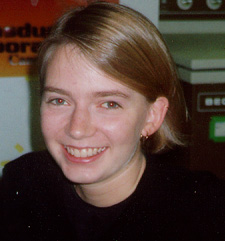Elaine Bucheimer
(UR '00)
reb2w@virginia.edu
www-lecb.ncifcrf.gov/~bucheime

| Regulation by cell cycle over the patterned
differentation of Anabaena
Elaine Bucheimer
(UR '00)
|
 |
Current Position
MD/PhD program, University of Virginia
Project at U. Richmond (1999-2000)
Previous experimentation has produced evidence to support
the idea that early pattern formation in a differentiating filament of
the cyanobacterium Anabaena is dependent on the positions of each
cell in the cell cycle. To test this, the promoter from the cell division
gene ftsZ will be fused to green fluorescent protein to produce
a fluorescent marker which is expressed only by cells at a characteristic
position in the cell cycle. HetR protein is present only in differentiating
cells, and therefore a fusion of the promoter for the hetR gene
and the gene for luciferase will be used as an indicator for differentiation
along the filament. The patterns of expression for these two different
markers will be observed simultaneously along a differentiating filament
and analyzed for any relationship within the patterns. This project attempts
to answer the lingering question of what is responsible for the patterned
appearance of heterocysts along an Anabaena filament and has applications
to pattern formation in higher organisms.
Project (Fall-Spring 1998/1999)
Visualization of the positions in the cell-cycle of
cells within filaments of the cyanobacterium
Anabaena
Project (Spring 1997)
Determining Nitrogenase Localization in Microcoleus
Chtonoplastes, a
Unique Marine Cyanobacterium
The two processes necassary for the survival of cyanobacteria, photosynthesis and nitrogen fixation, are incompatible because nitrogenase is deactivated in the presence of oxygen. Cyanobacteria have developed mechanisms to deal with this problem, primarily through heterocysts or by separating the two processes in time, with nitrogen fixation occurring at night and photosynthesis during the day. Microcoleus chtonoplastes is unique in that it uses an unknown mechanism different from these to fix nitrogen. This project attempts to determine a possible mechanism for nitrogen fixation by examining nitrogenase localization along the filament. The three main methods which will be tried include in situ hybridization, in situ PCR, and the use of a reporter gene. Hopefully, by locating regions of nitrogenase production we will be able to predict a method for nitrogenPresentations
fixation in this organism.
Awards
University Arts & Sciences Summer Fellowship, 1999